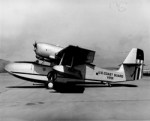
| DATOS TÉCNICOS (Modelo J4F-2) |
TECHNICAL DATA (Models J4F-2) |
| TIPO:Pentaplaza de patrulla costera o antisubmarina. | TYPE:Five-seat coastal or anti-submarine patrol aircraft. |
| TRIPULANTES:2 | CREW:2 |
| ENVERGADURA:12’19 m. | SPAN:40 ft. |
| LONGITUD:9’47 m. | LENGTH:31.1 ft. |
| ALTURA:3’48 m. | HEIGHT:11.5 ft. |
| SUPERFICIE ALAR:22’76 m². | WING AREA:245 ft² |
| PESO EN VACÍO:1.447 kg. | EMPTY WEIGHT:3,189 lb. |
| MOTOR:2 motores Ranger L-440-C-5 de 6 cilindros en línea y 200 caballos. | ENGINE:2 200-hp Ranger L-440-C-5 6-cylinder inline engines. |
| VELOCIDAD MÁX.:246 Km/h. | MAX. SPEED:153 mph. |
| TECHO:4.450 m. | CEILING:14,600 ft. |
| ALCANCE:1.481 kms. | RANGE:920 ml. |
| PRIMER VUELO:28 de junio de 1940. | FIRST FLIGHT:28 June 1940. |
| VERSIONES:7 | VERSIONS:7 |
| CONSTRUIDOS:131 | BUILT:131 |
El G-44 Widgeon puede considerarse en algunos aspectos como el sucesor del Grumman G-21 Goose. Considerando que había un mercado potencial en los Estados Unidos de preguerra para un avión comercial anfibio, Grumman diseñó una versión del Goose más pequeña y económica. El primer prototipo fue probado por Roy Grumman y Bud Gillies en junio de 1940. Ya se habían vendido 10 ejemplares antes de que se terminase la primera tanda de producción en febrero de 1941. El primer contingente de 44 aparatos iba destinado al mercado civil, pero 11 de ellos se asignaron a la Fuerza Aérea del Ejército bajo la denominación OA-14.
El segundo grupo de 25 aparatos producidos se entregaron entre julio de 1941 y junio de 1942. Todos se incorporaron al servicio de Guarda Costas norteamericano renombrados como J4F-1. Uno de ellos fue el responsable del hundimiento con cargas de profundidad del submarino alemán U-166 junto a la desembocadura del Mississippi en agosto de 1942. Este fue el primer hundimiento de un submarino enemigo en la historia de los Guarda Costas de EE.UU.
El siguiente modelo producido fue el J4F-2 de los que se hicieron 131 aparatos para la Marina. Se entregaron entre julio de 1942 y febrero de 1945. Pilotado por dos tripulantes podía transportar tres pasajeros y fue usado para misiones antisubmarinas y de patrullaje costero. La Royal Navy recibió 15 ejemplares por el Acuerdo de Préstamo y Arriendo que se usaron para transporte sobre todo en el Caribe. Se les renombró en principio como Gosling pero posteriormente se les conoció con el nombre estadounidense.
En 1944 Grumman inició la construcción de la versión mejorada G-44A que voló por vez primera en agosto de aquel año. Se rediseñó el casco mejorando la quilla. Se construyeron 76 hasta 1949, algunos con motor Continental W-670. Otros 41, llamados SCAN-30, se fabricaron bajo licencia por la Société de Construction Aéro-Navale (SCAN) en Francia entre 1948-49. La mayor parte fueron a compradores de EE.UU.
El fabricante McKinnon Enterprises de Oregón inició un plan de conversión para el Widgeon. El Super Widgeon incorporaba dos motores Avco Lycoming GO-480BID de 270 caballos y seis cilindros con hélices de tres palas que incrementaban considerablemente su velocidad máxima. También se mejoró su capacidad de combustible y el interior del fuselaje. El constructor entregó 70 de estas conversiones en los años 60. Hoy día aún vuelan Widgeon y Super Widgeon privados, algunos de ellos en servicios comerciales.
The G-44 Widgeon can in certain aspects be considered a sequel of the successful Grumman G-21 Goose. Considering there was a market in pre-war U.S. for a small commercial amphibian aircraft, Grumman designed a smaller and cheaper five-seat version of the Goose. The first prototype was flown by Roy Grumman and Bud Gillies in June 1940. Before the first production Widgeon was finished in February 1941, 10 examples had already been sold to private buyers. The first batch of 44 aircraft were intended for the civil market but 11 were assigned to the U.S. Army Air Force under the designation OA-14.
The second production run of 25 examples was delivered between July 1941 and June 1942. All of them were assigned to the U.S. Coast Guard which renamed them as J4F-1. One of these armed with depth charges sunk the German U-boat U-166 near the mouth of the Mississippi in August 1942. This was the first score of an enemy submarine in the U.S. Coast Guard history.
The next production model was the J4F-2, of which 131 aircraft were built for the U.S. Navy. They were delivered between July 1942 and February 1945. Operated by a crew of two and with up to three passengers in the utility transport role, the J4F-2 was also used for anti-submarine duties and coastal patrol. Fifteen of them were sent to the Royal Navy under the Lend-Lease Agreement and used for communication above all in the West Indies. These were first known as Gosling and later took the American name.
In 1944 Grumman introduced an improved G-44A which first flew in August that year. The hull was redesigned incorporating a deeper keel. A total of 76 was built until 1949 and some of them were re-engined with Continental W-670s. Some 41 G-44As were built under licence by the Société de Construction Aéro-Navale (SCAN) in France in 1948-49 and called SCAN-30. Most SCAN-30s were delivered to customers in the U.S.
The U.S. company McKinnon Enterprises from Oregon initiated a conversion plan for the Widgeon. The resulting Super Widgeon featured two 270-hp Avco Lycoming GO-480BID six-cylinder engines driving three blade propellers which increased top speed significantly. Fuel tankage and the hull interior were also improved. The Oregon firm finished 70 conversions in the 1960s. Today there is still a number of Widgeons and Super Widgeons flying in private hands, with a few in commercial service.
FUENTES Y REFERENCIA – SOURCES & REFERENCE
David Donald, American Warplanes of World War II, Grange Books, 2001.
©jmodels.net





Debe estar conectado para enviar un comentario.